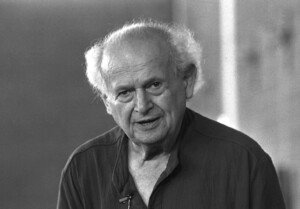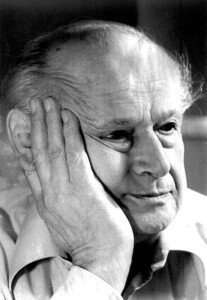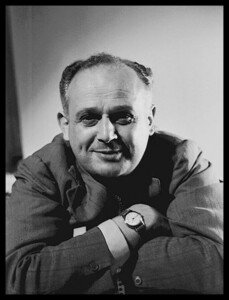What is the Feldenkrais Method®?
"Feldenkrais' method is the most sophisticated and effective method I have seen for the prevention and reversal of deterioration of function. We're condemning millions of people to a deteriorated old age that's not necessary.”
Margaret Mead cultural anthropologist (1901-1978)
The Feldenkrais Method® is for anyone who wants to reconnect with their natural abilities to move, think, and feel.
Whether you want to be more comfortable sitting at your computer, playing with your children and grandchildren, or performing a favourite pastime, these gentle lessons can improve your overall well-being.
Learning to move with less effort makes daily life easier. Because the Feldenkrais Method focuses on the relationship between movement and thought, increased mental awareness and creativity accompany physical improvements. Everyone, from athletes and artists to administrators and lawyers, can benefit from the Feldenkrais Method®.
After experiencing Feldenkrais® lessons, people often express feelings of relaxation and ease. They may breathe more freely and find their thoughts have more clarity. The learning process is full of pleasant surprises and personal breakthroughs.
Feldenkrais lessons teach you the means to take charge of your own improvement and are offered in two ways, enabling you to discover which learning style is most appropriate for your needs.
In Awareness Through Movement® lessons, the teacher verbally guides you through a sequence of gentle movements intended to help you develop a greater awareness of how you move. These lessons occur in a group setting.
Functional Integration® lessons are designed to meet your personal needs. Communicating through touch and movement in addition to words, the teacher guides you in your one-on-one process of self-discovery.
Regardless of which learning style you choose, the Feldenkrais Method can help you overcome limitations brought on by stress, misuse, accident, or illness.
About Moshe Feldenkrais
Moshe Pinhas Feldenkrais was born on May 6, 1904, in Slavuta, in the present-day Ukrainian Republic. When he was a small boy his family moved to the nearby town of Korets. By 1912 his family moved to Baranovich in what is, today, Belarus. While Baranovich endured many World War I battles, Feldenkrais received his Bar Mitzvah, completed two years of high school, and received an education in the Hebrew language and Zionist philosophy. In 1918 Feldenkrais left by himself on a six-month journey to Palestine.
After arriving in 1919, Feldenkrais worked as a laborer until 1923 when he returned to high school to earn a diploma. While attending school he made a living by tutoring. After graduating in 1925, he worked for the British survey office as a cartographer. Feldenkrais was involved in Jewish self-defense groups, and after learning Jujitsu he devised his own self-defense techniques. He hurt his left knee in a soccer match in 1929. While convalescing he wrote Autosuggestion (1930), a translation from English to Hebrew of Charles Brooks' work on Émile Coué's system of autosuggestion, together with two chapters that he wrote himself. He next published Jujitsu (1931), a book on self-defense.
In 1930 Feldenkrais went to Paris and enrolled in an engineering college, the École des Travaux publics de Paris. He graduated in 1933 with specialties in mechanical and electrical engineering. In 1933 after meeting Jigaro Kano, Judo's founder, Feldenkrais began teaching Jujitsu again, and started his training in Judo. In 1933 he began working as a research assistant under Frédéric Joliot-Curie at the Radium Institute, while studying for his Ingénieur-Docteur degree at the Sorbonne. From 1935-1937 he worked at the Arcueil-Cachan laboratories building a Van de Graaf generator, which was used for atomic fission experiments. In 1935 he published a revised, French edition of his Hebrew jujitsu book called, La défense du faible contre l'agresseur, and in 1938 published ABC du Judo. He received his Judo black belt in 1936, and 2nd degree rank in 1938. Feldenkrais married Yona Rubenstein in 1938. From 1939-1940 he worked under Paul Langevin doing research on magnetics and ultra-sound.
Feldenkrais escaped to England in 1940, just as the Germans arrived in Paris. As a scientific officer in the British Admiralty, he conducted anti-submarine research in Scotland from 1940-1945. While there he taught Judo and self-defense classes. In 1942 he published a self-defense manual, Practical Unarmed Combat, and Judo. Feldenkrais began working with himself to deal with knee troubles that had recurred during his escape from France, and while walking on submarine decks. Feldenkrais gave a series of lectures about his new ideas, began to teach experimental classes, and work privately with some colleagues.
In 1946 Feldenkrais left the Admiralty, moved to London, and worked as an inventor and consultant in private industry. He took Judo classes at the London Budokwai, sat on the international Judo committee, and scientifically analyzed Judo principles. He published his first book on his Method, Body and Mature Behavior in 1949, and his last book on Judo, Higher Judo, in 1952. During his London period he studied the work of George Gurdjieff, F. M. Alexander, and William Bates, and went to Switzerland to study with Heinrich Jacoby.
Feldenkrais returned to Israel to direct the Israeli Army Department of Electronics, 1951 - 1953. Around 1954 he moved permanently to Tel Aviv and, for the first time, made his living solely by teaching his Method. He worked sporadically on the manuscript of The Potent Self, which he had begun in London.
Around 1955 he permanently located his Awareness through Movement classes to a studio on Alexander Yanai Street in Tel Aviv. He gave Functional Integration lessons in the apartment where his mother and brother lived. In early 1957 Feldenkrais began giving lessons to Israeli Prime Minister, David ben Gurion.
In the late 1950's Feldenkrais presented his work in Europe and the United States. In the mid 1960s he published "Mind and Body" and "Bodily Expression." In 1967, he published Improving the Ability to Perform, titled Awareness through Movement in its 1972 English language edition. In 1968, near his family's apartment, he made a studio at 49 Nachmani Street as the permanent site for his Functional Integration practice, and location for his first teacher-training program, 1969-1971, given to 12 students.
After giving month-long courses internationally, he taught a 65-student, teacher-training program in San Francisco over four summers, 1975-1978. He published The Case of Nora in 1977, and The Elusive Obvious in 1981. He began the 235-student Amherst training in 1980, but was only able to teach the first two summers of the four-year program. After becoming ill in the fall 1981, he stopped teaching publicly. He died on July 1, 1984.
Written by Mark Reese
March 19, 2004
Mark Reese (1951-2006) was one of Feldenkrais’s original American students and studied with him from 1975 until Feldenkrais’s death in 1984. His book Moshe Feldenkrais: A Life in Movement, was published posthumously in 2015.





